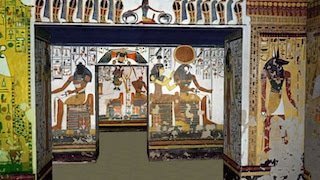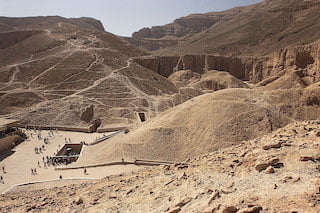 A lot of powerful people lived in the necropolis and it appears that a lot of money was spent wastefully. King Solomon had an incredible and expensive empire, but he had built You a temple and anyone that truly loves You would always buy the best for You.
A lot of powerful people lived in the necropolis and it appears that a lot of money was spent wastefully. King Solomon had an incredible and expensive empire, but he had built You a temple and anyone that truly loves You would always buy the best for You.
But these pharaohs, just like the Pope and a lot of preachers and evangelists today, I think Solomon would call that vanity.
 The words of the Preacher, the son of David, king in Jerusalem.
The words of the Preacher, the son of David, king in Jerusalem.
Vanity of vanities, saith the Preacher, vanity of vanities; all is vanity.
What profit hath a man of all his labor which he taketh under the sun?
One generation passeth away, and another generation cometh: but the earth abideth forever.
The sun also ariseth, and the sun goeth down, and hasteth to his place where he arose.
The wind goeth toward the south, and turneth about unto the north; it whirleth about continually, and the wind returneth again according to his circuits.
All the rivers run into the sea; yet the sea is not full; unto the place from whence the rivers come, thither they return again.
All things are full of labor; man cannot utter it: the eye is not satisfied with seeing, nor the ear filled with hearing.
The thing that hath been, it is that which shall be; and that which is done is that which shall be done: and there is no new thing under the sun.
Is there anything whereof it may be said, See, this is new? it hath been already of old time, which was before us.
There is no remembrance of former things; neither shall there be any remembrance of things that are to come with those that shall come after.
I the Preacher was king over Israel in Jerusalem.
And I gave my heart to seek and search out by wisdom concerning all things that are done under heaven: this sore travail hath God given to the sons of man to be exercised therewith.
I have seen all the works that are done under the sun; and, behold, all is vanity and vexation of spirit.
That which is crooked cannot be made straight: and that which is wanting cannot be numbered.
I communed with mine own heart, saying, Lo, I am come to great estate, and have gotten more wisdom than all they that have been before me in Jerusalem: yea, my heart had great experience of wisdom and knowledge.
And I gave my heart to know wisdom, and to know madness and folly: I perceived that this also is vexation of spirit.
For in much wisdom is much grief: and he that increaseth knowledge increaseth sorrow (Ecc 1).
In my opinion, anything you spend money on that isn’t useful or is bought to please others is a waste. I guess that would be the same as being vain.
Anyway, I want to get a closer look at…
Ezekiel 42
The Priests’ Chambers
1 Then he brought me forth into the utter court, the way toward the north: and he brought me into the chamber that was over against the separate place, and which was before the building toward the north.
2 Before the length of an hundred cubits was the north door and the breadth was fifty cubits.
3 Over against the twenty cubits which were for the inner court, and over against the pavement which was for the utter court, was gallery against gallery in three stories.

Valley of the Queens, also called Valley of the Tombs of the Queens, Arabic Wādī al-Bībān al-Harīm, or Wādī al-Harīm, gorge in the hills along the western bank of the Nile River in Upper Egypt. It was part of ancient Thebes and served as the burial site of the queens and some royal children of the 19th and 20th dynasties (1292–1075 bc).
On the west bank of the Nile across the river from Thebes, now modern day Luxor, lies an area known as the Valley of the Queens or Wadi el-Melikat. It is estimated that this necropolis contains about eighty rock cut tombs in all, some of which are lavishly decorated.
The Valley of the Queens, like the nearby and better known Valley of the Kings, is an isolated valley in the western hills which was chosen due to its relative proximity to Thebes.
The queens’ necropolis is located about 1.5 miles (2.4 km) west of the mortuary temple of Ramses III (1187–56 bc) at Madīnat Habu. There are more than 90 known tombs, usually consisting of an entrance passage, a few short halls, and a sarcophagus chamber.
The earliest may be that of Sitre, wife of Ramses I. The most notable are those of Nefertari, the favourite queen of Ramses II; of Princes Khaemwese and Amonhirkhopsef; and of a Ramesside queen called Titi.
4 And before the chambers was a walk of ten cubits breadth inward, a way of one cubit; and their doors toward the north.
5 Now the upper chambers were shorter: for the galleries were higher than these, than the lower, and then the middlemost of the building.
6 For they were in three stories, but had not pillars as the pillars of the courts: therefore the building was straitened more than the lowest and the middlemost from the ground.
7 And the wall that was without over against the chambers, toward the utter court on the forepart of the chambers, the length thereof was fifty cubits.
8 For the length of the chambers that were in the utter court was fifty cubits: and, lo, before the temple were a hundred cubits.
9 And from under these chambers was the entry on the east side, as one goeth into them from the utter court.
10 The chambers were in the thickness of the wall of the court toward the east, over against the separate place, and over against the building.
11 And the way before them was like the appearance of the chambers which were toward the north, as long as they, and as broad as they: and all their goings out were both according to their fashions, and according to their doors.
12 And according to the doors of the chambers that were toward the south was a door in the head of the way, even the way directly before the wall toward the east, as one entereth into them.
13 Then said he unto me, The north chambers and the south chambers, which are before the separate place, they be holy chambers, where the priests that approach unto the LORD shall eat the most holy things: there shall they lay the most holy things, and the meat offering, and the sin offering, and the trespass offering; for the place is holy.
14 When the priests enter therein, then shall they not go out of the holy place into the utter court, but there they shall lay their garments wherein they minister; for they are holy; and shall put on other garments, and shall approach to those things which are for the people.
15 Now when he had made an end of measuring the inner house, he brought me forth toward the gate whose prospect is toward the east, and measured it round about.
16 He measured the east side with the measuring reed, five hundred reeds, with the measuring reed round about.
17 He measured the north side, five hundred reeds, with the measuring reed round about.
18 He measured the south side, five hundred reeds, with the measuring reed.
19 He turned about to the west side, and measured five hundred reeds with the measuring reed.
20 He measured it by the four sides: it had a wall round about, five hundred reeds long, and five hundred broad, to make a separation between the sanctuary and the profane place.
The Necropolis
The necropolis lies on the western bank of the Nile at Luxor. Its monuments include a series of mortuary temples built by the pharaohs of the New Kingdom, royal tombs in the Valley of the Kings and the Valley of the Queens, and hundreds of tombs of noblemen that extend from the Dra Abu el Naga in the north to the Asasif in the south.

The beautiful tomb of Queen Nefertari, Great Royal Wife of Pharaoh Ramesses II, in the Valley of the Queens in Egypt. Dating from about 1300 BC. You can go down the steps and explore.
Alternatively the roofs or some of the walls, which have been made as groups, which can be moved or hidden so you can see inside that way. This model is reasonably accurate. The upper section is complete, in terms of wall paintings, the burial chamber is mostly complete.
The tomb was discovered in 1904 by an Italian expedition under Scapiarelli. It comprises an antechamber reached by a descending flight of steps, with a narrow cestibule to the right, and a chamber beyond the vestibule called the First Eastern Annex.
A diagonal, descending stairway, with alcoves on either side, leads down from the Antechamber to the Burial Chamber, which is supported by four oblong pillars, and has three smaller chambers leading off. The sarcophagus would have been situated in the lower part of the burial chamber, but few artefacts survived the plundering of antiquity.
The tomb itself is a treasure, due to the quality of its paintings, showing scenes from the book of the dead, and the elegant queen making offerings to various gods being welcomed by them into the afterlife. The ceilings are painted as starry skies.

It was part of the ancient city of Thebes and was the burial site of almost all the kings (pharaohs) of the 18th, 19th, and 20th dynasties (1539–1075 bce), from Thutmose I to Ramses X. Located in the hills behind Dayr al-Baḥrī, the 62 known tombs exhibit variety both in plan and in decoration.
Although it is known as the “city of the dead,” the necropolis was once a populated and busy community. Beside each mortuary temple there were dwellings for the different orders of priests, stalls for sacrificial animals, guard-houses and store-houses, each with its superintendent.
Surrounding, or in front of each temple there were lakes, groves and beautifully laid out gardens; some of the plants were imported from Syria and Punt.
The pharaohs themselves took up temporary residence on the necropolis to watch the progress being made on their mortuary temples, and supervise their construction and decoration.
Excavations at Kurna, the Ramesseum and Medinet Habu have revealed large palaces with numerous chambers. The largest and best preserved of these complexes lies to the south of Medinet Habu, where Ramses III watched his name being carved, literally, in history.
Also on the necropolis, at Deir el Medina, was a village of workers who carried out the secret task of digging and decorating the royal tombs in the Valley of the Kings.
Excavations over the last half century have revealed that this walled city contained some eighty families. Their professions ranged from quarrying and mortar- mixing, to draughting, painting and designing. There were scribes and foremen, and a director of works who headed the community.
Each family had a simple, sparsely furnished house, and they constructed the tombs nearby. From the tombs at Deir el Medina, and from some 40,000 pieces of inscribed pottery (ostraka) found at the site, archaeologists have been able to trace the activities of this community for generation upon generation, throughout a span of nearly three centuries.
Their very personalities have been revealed: pride in their professional activities, joy at family celebrations, and even their grievances.
…Pharaoh Ramesses II.
Visits: 0


